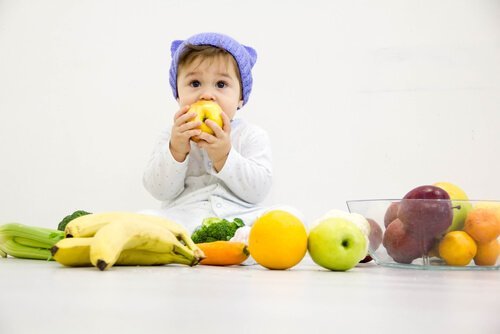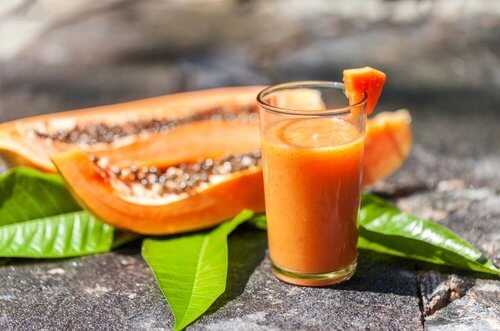4 Fruit Juices for Children

The World Health Organization recommends exclusively breastfeeding until the age of 6 months. Once this period of time has passed, babies can begin to drink their first fruit juices, which provide essential nutrients for health and development.
A baby’s body isn’t prepared to properly digest all foods. That’s why it’s necessary to introduce new foods gradually so that he can get used to them. This way your baby will be able to expand his diet and also enjoy the nutritional benefits of a variety of foods, little by little.
The adaptation process
Fruits provide your baby with vitamins, minerals, amino acids, fiber, healthy calories and carbohydrates like glucose, sucrose and fructose. Because they contain a high percentage of water, they also help your baby stay hydrated.

It should be noted that there may be some mild adverse reactions in the process of adapting to new foods. Usually, these are allergies that you don’t need to worry about too much because they will pass. However, it’s advisable to consult with your pediatrician to make sure it’s normal.
Tips for giving fruit juices to infants
Giving fruits to children in the form of smoothies and juices will help them get used to the new flavors and textures. Here are some tips to keep in mind before starting to give children fruit juices:
Choosing the fruit
- Prepare the juice of one fruit at a time and wait a few days before introducing a different fruit.
- Offer apple, pear, orange, tangerine, plum or grape juice first. Berries and tropical fruits should be postponed a little, since they have a strong flavor for babies.
- Choose ripe and seasonal fruits, since they’re easier for the baby to digest.
Preparing the fruit
- The juices must be natural. Avoid processed juices that contain preservatives and other chemical additives. While these offer comfort to parents, they aren’t very beneficial to young children.
- Don’t sweeten the juice artificially. This allows the child to enjoy the fruit’s original flavor.
- It’s best to prepare the fruit without water, or with very little water, in order to take full advantage of all the fruit’s properties.
- Maintain good hygiene to avoid contaminating the fruit juice with germs or possible allergens. Of course, the accessories that are used must be very clean.
Giving the juice
- Feed the juice with a spoon.
- Carefully observe the baby’s reactions for the possibility of intolerance, allergies, diarrhea, etc.
- Once the fruit juice is ready, it’s best to consume it as soon as possible, to avoid the oxidation effect.
- Start with small amounts of fruit and then gradually increase the amount until the child becomes familiar with the taste of the fruit.
4 fruit juices for children
1. For infants
Ingredients
1 serving of apple, pear, plum, grape, peach, orange or tangerine
Preparation
- Peel and wash the chosen fruit. Remove the seeds.
- Blend the fruit in a blender (avoid using water as much as possible). Citrus fruits can simply be squeezed manually or with the help of a juicer.
- Strain the juice to remove all possible remains of seeds.
- Don’t remove all the pulp, as it’s important for the child to learn to consume this too.
2. For children 12 months and older
Ingredients
- 1 cup of water
- 1/2 small ripe papaya
- 1 drop of vanilla extract
Preparation
- Peel and wash the papaya
- Remove the seeds
- Blend in a blender
- Add the vanilla
- Mix
3. For children older than 3 years
Ingredients
- 4 ice cubes
- 1 large ripe mango
- 1 sugar-free Greek yogurt
- 1/4 teaspoon ground cardamom
Preparation
- Peel, wash and remove the mango seed.
- Chop the fruit and crush it in the electric mixer with the yogurt, cardamom and ice.
- Serve.

4. For children 24 months and older
Ingredients
- 1/2 ripe papaya
- 1 ripe banana
- 4 ice cubes
- 1/2 ripe pineapple
Preparation
- Chop all the fruit after peeling, washing and removing the seeds.
- Blend in a blender.
- Add ice.
Some considerations
To develop properly and stay healthy, the body needs nutrients in proportional quantities, according to size and age. If we regularly incorporate these fruit juices into our baby’s diet, we’ll be fulfilling a good part of their nutritional requirements.
The child will also grow to enjoy the taste of fruits and include them in his own diet throughout his life.
All cited sources were thoroughly reviewed by our team to ensure their quality, reliability, currency, and validity. The bibliography of this article was considered reliable and of academic or scientific accuracy.
- Zhao X., Zhang M., Li C., Jiang X., et al., Benefits of vitamins in the treatment of Parkinson’s disease. Oxid Med Cell Longev, 2019.
- Jensen T., Abdelmalek MF., Sullivan S., Nadeau KJ., et al., Fructose and sugar: a major mediator of non alcoholic fatty liver disease. J Hepatol, 2018. 68 (5): 1063-1075.
This text is provided for informational purposes only and does not replace consultation with a professional. If in doubt, consult your specialist.
